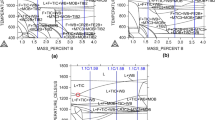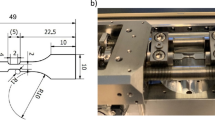Conclusions
-
1.
Raising the quenching temperature of commercial carbon steels to 1180–1200°C produces a mixture of massive and twin martensite.
-
2.
The temperature range in which massive martensite is formed is higher than the range in which twin martensite is formed and coincides with the range in which bainite is formed.
-
3.
The limit concentration of carbon corresponding to a shift from the massive to twin martensite transformation depends on the cooling rate-with increasing cooling rates the carbon concentration at which twin martensite is formed decreases.
-
4.
The critical cooling rate for formation of massive martensite is lower than for twin martensite.
-
5.
The nature and kinetics of the formation of bainite and massive martensite are similar. Differences in the structures are due to the carbon content, since diffusional redistribution of carbon occurs in the process of the transformation. Thus, it is expedient to use the term bainite for carbon-containing alloys and massive martensite (isothermal) for carbon-free alloys (<0.1% C).
Similar content being viewed by others
Literature cited
A. Marder and G. Krauss, TASM,62, 957 (1969).
A. Marder and G. Krauss, TASM,60, No. 1, 651 (1967).
G. Speich, J. Iron Steel Inst.,206, No. 4, 385 (1968).
G. V. Korotushenko, V. I. Grigorkin, and A. G. Zinchenko, "Fracture toughness at −196°C of steels with a structure of high-temper bainite and massive martensite," Izv. Akad. Nauk SSSR, Met., No. 5, 132 (1976).
G. Boda and D. Mack, Met. Trans.,1, 50 (1970).
M. L. Bernshtein et al., "Transformation of austenite in low-carbon steel," Metalloved. Term. Obrab. Met., No. 10, 54 (1976).
A. D. Assonov, Heat Treatment of Machine Parts [in Russian], Mashinostroenie, Moscow (1969), p. 41.
A. Marder and J. Marder, TASM,2, No. 1 (1969).
G. Speich and W. Leslie, Met. Trans.,3, 1043 (1972).
G. V. Korotushenko et al., "Mechanical properties and kinetics of the bainitic transformation in steels 35NKh3MFA and 25KhN3MFA," Izv. Akad. Nauk SSSR, Met., No. 2, 180 (1978).
M. Umemoto and C. Wayman, Acta Met., No. 10, 1529 (1978).
Additional information
Translated from Metallovedenie i Termicheskaya Obrabotka Metallov, No. 6, pp. 2–6, June, 1979.
Rights and permissions
About this article
Cite this article
Korotushenko, G.V., Grigorkin, V.I., Vashchenko, I.P. et al. Kinetics of the massive martensitic transformation in commercial carbon steels. Met Sci Heat Treat 21, 407–412 (1979). https://doi.org/10.1007/BF00780472
Issue Date:
DOI: https://doi.org/10.1007/BF00780472




